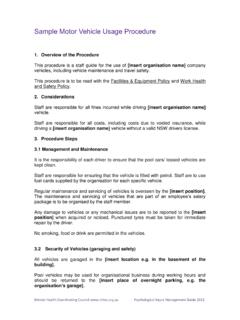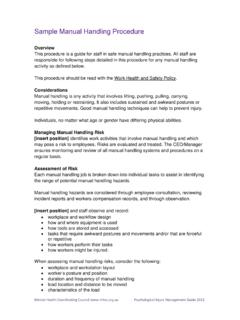Transcription of Sample Risk Management Policy and Procedure
1 Mental Health Coordinating Council Psychological Injury Management Guide 2012 Sample Risk Management Policy and Procedure 1. Purpose and Scope This Policy establishes the process for the Management of risks faced by [organisation]. The aim of risk Management is to maximise opportunities in all [organisation] activities and to minimise adversity. The Policy applies to all activities and processes associated with the normal operation of [organisation]. It is the responsibility of all Board members, staff, students and volunteers to identify, analyse, evaluate, respond, monitor and communicate risks associated with any activity, function or process within their relevant scope of responsibility and authority. This Policy does not detail consumer risk Management . See xxx Policy .
2 2. Definitions Risk is the likelihood is the likelihood that a harmful consequence (death, injury or illness) might result when exposed to a hazard. Risk is characterised and rated by considering two characteristics: 1. Probability or likelihood (L) of occurrence; and 2. Consequence (C) of occurrence. This is expressed as R (risk) = L (likelihood) x C (consequence). Likelihood is a qualitative description of probability or frequency. Consequence is the outcome of an event, being a loss, injury, disadvantage or gain. There may be a range of possible outcomes associated with an event. Risk control means taking action to first eliminate health and safety risks so far as is reasonably practicable, and if that is not possible, minimising the risks so far as is reasonably practicable. Eliminating a hazard will also eliminate any risks associated with that hazard Risk Assessment is the process of evaluating and comparing the level of risk against predetermined acceptable levels of risk.
3 Risk Management is the application of a Management system to risk and includes identification , analysis, treatment and monitoring. Mental Health Coordinating Council Psychological Injury Management Guide 2012 Risk Owner is the person(s) responsible for managing risks and is usually the person directly responsible for the strategy, activity or function that relates to the risk. 3. Principles Risk Management is a key governance and Management function. [organisation] is proactive in its approach to risk Management , balances the cost of managing risk with anticipated benefits, and undertakes contingency planning in the event that critical risks are realised. [organisation] has the primary duty to ensure the health and safety of workers and other persons at the workplace. A duty to ensure health and safety requires [organisation] to manage risks : by eliminating health and safety risks so far as is reasonably practicable; and if it is not reasonably practicable to eliminate the risks , by minimising those risks so far as is reasonably practicable.
4 Deciding what is reasonably practicable to protect people from harm requires weighing up certain matters, including the likelihood of a hazard or risk occurring and the degree of harm that would result, and then making a judgement about what is reasonable in the circumstances. Effective risk Management involves: a commitment to health and safety from the [organisation] Board of Directors the involvement and cooperation of [organisation] s workers 4. Outcomes As far as is reasonably practicable, workers, consumers and other persons are not put at risk from work carried out by [organisation]. [organisation] is protected from adverse incidents, reduces its exposures to loss, and mitigates and controls loss should it occur. [organisation] has ongoing, unimpeded capacity to fulfil its mission, perform its key functions, meet its objectives and support its consumers.
5 The costs of risk to [organisation], and its funders, is reduced. Mental Health Coordinating Council Psychological Injury Management Guide 2012 5. Functions and Delegations A person can have more than one duty and more than one person can have the same duty at the same time. Position Delegation/Task Board of Directors Exercise due diligence to ensure that [organisation] complies with the WHS Act and Regulations. This includes taking reasonable steps to: gain an understanding of the hazards and risks associated with the operations of [organisation], and ensure that [organisation] has and uses appropriate resources and processes to eliminate or minimise risks to health and safety. Management CEO Ensure, so far as is reasonably practicable, that workers and other persons are not put at risk from work carried out by [organisation].
6 Ensure, so far as is reasonably practicable, that: the workplace, including entry and exit and anything arising from the workplace are without risks to health and safety the fixtures, fittings or plant are without risks to health and safety the plant, substance or structure is without risks to health and safety. Establish and implement risk Management systems for all functions and activities of [organisation]. Staff Compliance with Risk Management Policy . Contribute to the establishment and implementation of risk Management systems for all functions and activities of [organisation]. 6. Risk Management All Board members and staff contribute to the establishment and implementation of risk Management systems for all functions and activities of [organisation]. Risk Management practice aligns with all federal and state legislation.
7 7. Policy Implementation Risk Management forms part of strategic, operational and line Management responsibilities, and is integrated into strategic and service planning processes. Risk Management is embedded in all policies and procedures , with workers contributing to risk Management systems. Mental Health Coordinating Council Psychological Injury Management Guide 2012 8. Policy Detail [organisation] aims to achieve better practice in the Management of risks that threaten to adversely impact on [organisation], its functions, objectives, operations, assets, staff, consumers or members of the public. [organisation] does whatever it can (whatever is reasonably practicable ) to ensure its workers, consumers and other people are not harmed by its activities. Risk Management involves four steps (see Figure 1 below): 1.
8 Identify hazards find out what could cause harm 2. assess risks understand the likelihood of a hazard causing harm and how serious it could be, 3. control risks implement the most effective control measure that is reasonably practicable in the circumstances, and 4. review control measures to ensure they are working as planned. Many hazards and their associated risks are well known and have well established and accepted control measures. In these situations, the second step to formally assess the risk is unnecessary. If, after identifying a hazard, we already know the risk and how to control it effectively, [organisation] just implements the controls. Consulting with workers Consultation with workers and their health and safety representatives is required at each step of the risk Management process.
9 By drawing on the experience, knowledge and ideas of its workers [organisation] is more likely to identify all hazards and choose effective risk controls. [organisation] workers must follow safety instructions and procedures , and they will do this more effectively if they are involved in the development of these procedures , understand the reasons for them and how they work. Figure 1: The risk Management process (from Worksafe Australia, 2010, p6) Mental Health Coordinating Council Psychological Injury Management Guide 2012 [organisation] encourages its workers to report any hazards and health and safety problems immediately so that risks can be managed before an incident occurs. If [organisation] has a health and safety committee, [organisation] will engage the committee in the risk Management process as well.
10 For more details, see WHS Consultation Procedure . When should a risk Management approach be used? Managing work health and safety risks is an ongoing process that is triggered when changes affect [organisation] s work activities changes such as: New program start-up changing work practices, procedures or the work environment purchasing new or used equipment or using new substances planning to improve productivity or reduce costs new information about workplace risks becomes available responding to workplace incidents (even if they have caused no injury) responding to concerns raised by workers, health and safety representatives or others at the [organisation] workplace, and as required by WHS regulations for specific hazards [organisation] also uses the risk Management approach when designing and creating products, processes or places used for work, because it is often easier and more effective to eliminate hazards before they are introduced into a workplace and to incorporate safety features in the early stages of product or process development.



